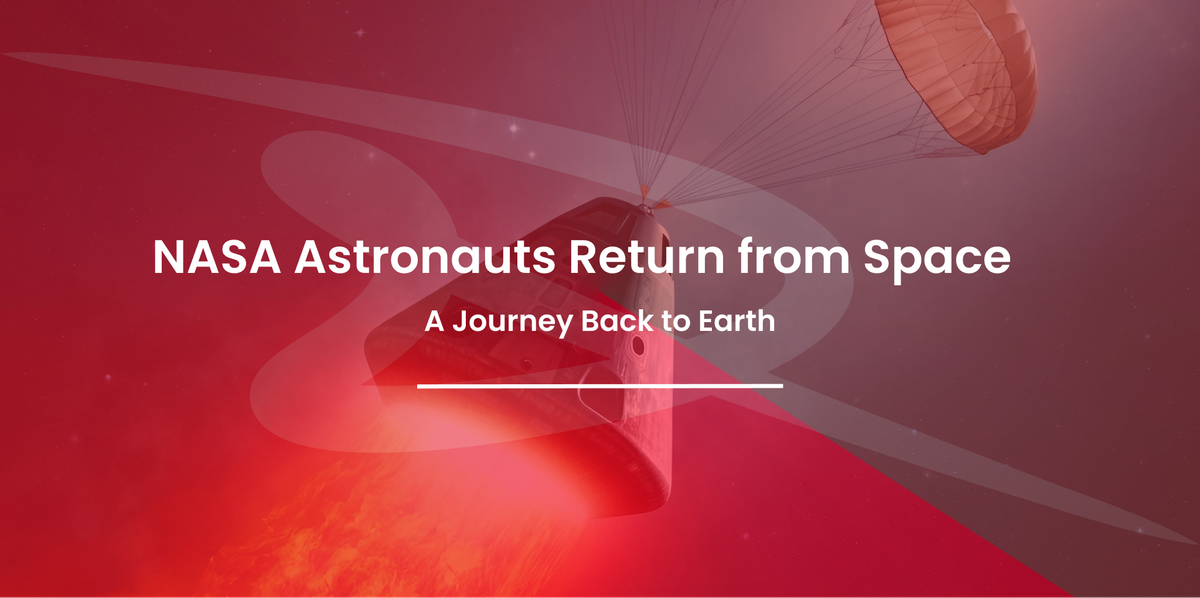NASA Astronauts Return from Space: A Journey Back to Earth
Discover how NASA astronauts return from space to Earth. Learn about their re-entry, challenges, and recovery, plus what’s next for NASA’s space missions.

Introduction
After spending months aboard the International Space Station (ISS), a team of NASA astronauts has safely returned to Earth, marking the end of yet another remarkable chapter in space exploration. Returning to Earth isn’t as simple as hopping into a spacecraft and boarding a flight back home. It’s a highly complex process that involves careful preparation, overcoming substantial physical challenges, and enduring a fiery descent back through Earth's atmosphere.
This mission included astronauts, who spent 200+ days aboard the ISS conducting critical research, maintaining onboard systems, and even testing new technologies that will impact future space missions. The purpose of their stay stretched beyond exploration; it served to advance scientific understanding and prepare for humanity's next steps into deep space.
But how do astronauts actually make the perilous return journey from space? What challenges do they encounter? And what lies ahead for NASA’s bold future missions? Let’s take a look.
The Re-Entry Process: How Astronauts Return to Earth
Preparation for Re-Entry
Before beginning the descent to Earth, astronauts follow an intricate preparation process:
- Checking Space Suits and Equipment: Astronauts ensure their suits are in perfect working condition, as these provide life support and protection during the descent. The spacecraft’s systems are also thoroughly checked to ensure a safe re-entry.
- Saying Farewell to ISS Crew Members: Goodbyes are said to the fellow astronauts who remain aboard the ISS. It’s an emotional moment, as teams bond closely during their months-long missions.
Undocking from the ISS
The return begins when the spacecraft, such as SpaceX’s Crew Dragon or a Soyuz capsule, successfully undocks from the ISS. At this point, the vehicle initiates a controlled descent trajectory. The spacecraft’s thrusters are used to adjust positioning, and soon, the pull of Earth’s gravity begins to take over.
Re-Entry into Earth’s Atmosphere
Re-entry into Earth’s atmosphere is one of the most intense phases of the return. As the spacecraft speeds down at thousands of miles per hour, it faces extreme heat and friction created by atmospheric resistance. Heat shields play a crucial role here, protecting both the spacecraft and its passengers by withstanding temperatures reaching up to 3,000°F (about 1,650°C).
Astronauts describe this phase as a "fiery plunge" where the glow of superheated plasma can be seen just outside the spacecraft’s windows. Communication with mission control may temporarily go silent due to interference, adding an additional layer of tension.
Parachute Deployment & Landing
The descent slows significantly with the deployment of a series of parachutes, which help the spacecraft achieve a manageable velocity for its landing. Whether it’s a splashdown in the ocean, as with a SpaceX Crew Dragon capsule, or a firm landing on land, like the Soyuz capsules in Kazakhstan, precision is key. Recovery teams are always on standby at predetermined landing sites to retrieve the astronauts and their spacecraft swiftly.
Challenges Astronauts Face During Return
Returning from space isn’t just physically demanding; it’s a full-body challenge unlike any other.
G-Forces and Extreme Temperatures
Astronauts endure intense G-forces during re-entry, which can feel like experiencing multiple times the Earth's gravitational force. This immense pressure affects movement and breathing, requiring astronauts to rely on their training.
Weightlessness to Gravity Transition
After months of living in zero gravity, the transition to Earth’s pull can be tough. Bones and muscles, which have weakened in the microgravity environment, now face the demands of Earth’s gravity again.
Motion Sickness & Muscle Weakness
Many astronauts report symptoms of space motion sickness on return, ranging from dizziness to nausea. Balance and coordination can also be affected as the body adjusts back to Earthly conditions.
Recovery and Medical Checks
Once back on Earth, recovery teams—including medical experts and engineers—spring into action.
Immediate Medical Assessments
Astro-medical teams conduct on-site health evaluations to ensure the astronauts are stable and healthy post-landing. These checks include monitoring heart rate, blood pressure, and fluid levels.
Rehabilitation Programs
Recovery continues back at base, where astronauts undergo specialized rehabilitation programs. These help rebuild muscle strength, restore bone density, and improve coordination. Over weeks to months, participants re-train their bodies to function optimally under gravity’s pull.
These efforts are critical not only for short-term recovery but also to prepare astronauts for future missions.
NASA’s Future Space Missions
Returning from the ISS may be a thrilling feat, but NASA looks to even greater horizons.
Artemis Missions to the Moon
Under the ambitious Artemis program, NASA plans to send humans back to the Moon. These missions, scheduled for the coming years, also lay the groundwork for long-duration space travel and deep-space habitation.
The Role of Commercial Space Companies
NASA’s close collaboration with companies like SpaceX and Boeing is revolutionizing space exploration. It’s a new era where private innovations like Crew Dragon capsules ensure quicker, more efficient, and safer space flights.
Preparing for Mars Exploration
Every mission to the ISS and the Moon builds on humanity’s ultimate goal of venturing to Mars. With extensive crew safety training, advanced spaceship designs, and innovative life support systems, NASA is constantly taking steps closer to making the Red Planet a reality.
Looking Forward to NASA’s Next Adventures
The triumphant return of NASA astronauts from space represents not only a successful mission but also humanity’s relentless pursuit of discovery. These astronauts carry with them invaluable data, experience, and stories that will shape the next era of exploration—from the Moon to Mars and beyond.
As we celebrate their safe arrival, we are reminded of the courage and dedication it takes to push the boundaries of human potential. One question remains on everyone’s lips though: Where will NASA explore next?

Comments ()